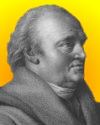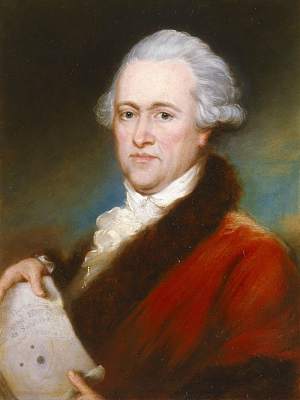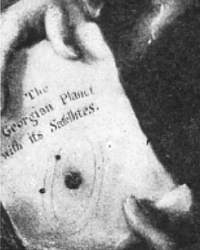 (source)
(source)
|
Sir William Herschel
(15 Nov 1738 - 25 Aug 1822)
German-English astronomer who initiated sidereal astronomy for the systematic observation of the heavens.
|
HERSCHEL
from The Library of Original Sources (1907)

[p. 335] Sir William Herschel was born in Hanover, Germany, November 15, 1738. He was the son of a bandmaster and was specially educated in music. At fourteen he was forced to earn his own living and joined the band of the Hanoverian Guards. This took him to England in 1759. He later became organist at Bath. All this time he studied the languages and mathematics by himself. He grew to be much interested in the science of music and was led from this to take interest in the fabled “music of the spheres.”
Even an ordinary telescope was beyond his means, and he at length, after some 200 failures, succeeded in constructing specula for a telescope that he considered satisfactory. In 1781 with one of his own telescopes he discovered the planet Uranus, thought at first to be a comet. Honors now fell fast upon him. He discovered two of the satellites of Uranus, two more of Saturn, and that the moon is without atmosphere; noted many of the binary stars; made the great inference from the movements of the stars that the whole solar system is rushing toward the constellation of Hercules; and pointed out many nebulous stars, which led directly to the nebular theory of the universe.
He died in 1822. His one son, Sir John Herschel, became also a famous astronomer.
THE DISCOVERY OF URANUS
Account Of A Comet
On Tuesday, the 13th of March, 1781, between ten and eleven in the evening, while I was examining the small stars in the neighborhood of H Geminorum, I perceived one that appeared visibly larger than the rest: being struck with its uncommon magnitude, I compared it to H Geminorum and the small star in the quartile between Auriga and Gemini, and finding it so much larger than either of them, suspected it to be a comet.
I was then engaged in a series of observations on the parallax [p.336] of the fixed stars, which I hope soon to have the honour of laying before the R. S.; and those observations requiring very high powers, I had ready at hand several magnifiers of 227, 460, 932, 1536, 2010, &c., all of which I have successfully used on that occasion. The power I had on when I first saw the comet was 227. From experience I knew that the diameters of the fixed stars are not proportionally magnified with higher powers, as the planets are; I therefore I now put on the powers of 460 and 932, and found the diameter of the comet increased in proportion to the power, as it ought to be, on a supposition of its not being a fixed star, while the diameters of the stars to which I compared it, were not increased in the same ratio. Moreover, the comet being magnified much beyond what its light would admit of, appeared hazy and ill-defined with these great powers, while the stars preserved that lustre and distinctness which from many thousand observations I knew they would retain. The sequel has shown that my surmises were well founded, this proving to be the Comet we have lately observed.
I have reduced all my observations upon this Comet to the following tables. The first contains the measures of the gradual increase of the Comet’s diameter. The micrometers I used, when every circumstance is favourable, will measure extremely small angles, such as do not exceed a few seconds, true to 6, 8, or 10 thirds at most; and in the worst situations true to 20 or 30 thirds; I have therefore given the measures of the Comet’s diameter in seconds and thirds.1
The first table, containing the measures of the comet’s diameter, shows that, from March 17 to April 18, the apparent diameter had increased from 2'' 53''' to 5'' 20'''.
The second table contains the comet’s distances from several telescopic fixed stars from March 13 till April 19, and those distances expressed in minutes, seconds and thirds. And the third table contains the comet’s angle of position with regard to the parallel of declination of the same stars measured by a micrometer; by which means its places and apparent path might be determined.

Detail of 'The Georgian Planet With Its Satellites'
On The Name Of The New Planet

By the observations of the most eminent astronomers in Europe it appears that the new star, which I had the honour of pointing out to them in March, 1781, is a Primary Planet of our Solar System.* A body [p. 337] so nearly related to us by its similar condition and situation, in the unbounded expanse of the starry heavens, must often be the subject of conversation, not only of astronomers, but of every lover of science in general. This consideration, then, makes it necessary to give it a name, by which it may be distinguished from the rest of the planets and fixed stars.
In the fabulous ages of ancient times the appellations of Mercury, Venus, Mars, Jupiter, and Saturn, were given to the planets, as being the names of their principal heroes and divinities. In the present more philosophical era, it would hardly be allowable to have recourse to the same method, and call on Juno, Apollo, Pallas or Minerva, for a name to our new heavenly body. The first consideration in any particular event, or remarkable incident, seems to be its chronology; if in any future age it should be asked, when this last-found planet was discovered? It would be a very satisfactory answer to say, “In the reign of King George the Third.” As a philosopher, then, the name of GEORGIUM SIDUS presents itself to me, as an appellation which will conveniently convey the information of the time and country where and when it was brought to view...2
*The observations on this new planet, at first suspected to be a comet, .... Dr. Herschel, the discoverer, here calls it the Georgium Sidus, or Georgian planet, in honour of his Majesty; by which name it is commonly distinguished in this country [England]. But, in other countries it is often called by other names; as Ouranus, Uranius, Herschel, &c. Its Astronomical mark, or character is H. By later observations and calculations it has been determined that the diameter of this planet is about 35,109 miles, or [4.4] times that of the earth; its distance from the sun 1800 millions of miles, or above 19 times the earth’s distance; that the period of its revolution in its orbit round the sun, is 83 years, 140 days, 17 hours, Dr. Herschel has also discovered 6 satellites or moons belonging to this planet, whose orbits are nearly perpendicular to the plane of the ecliptic; and they all perform their revolutions in their orbits contrary to the order of the signs, that is, their real motion is retrograde.3
1. Extract from 'Account of a Comet. By Mr. Herschel, F. R. S.; Communicated by Dr. Watson, Jun. of Bath, F. R. S.' (Read 26 Apr 1781) In Philosophical Transactions of the Royal Society of London (1781), 71, 492-493.
2. Extract from 'A Letter from William Herschel, Esq. F. R. S., to Sir Joseph Banks, Bart. P. R. S.', Philosophical Transactions of the Royal Society of London, (1783), 73, 1-2.
3. Footnote as seen in the later 1809 compilation of The Philosophical Transactions of the Royal Society of London (1781-1785), Abridged, With Notes... Vol. 15, From 1781-1785 (1809), 324-325. It is from this abridged collection that The Library of Original Sources quoted.
- Science Quotes by Sir William Herschel.
- 15 Nov - short biography, births, deaths and events on date of Herschel's birth.
- Booklist for William Herschel.




